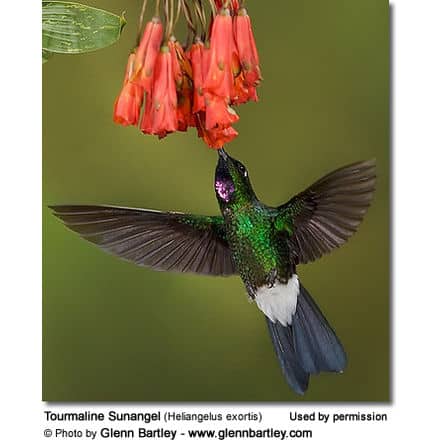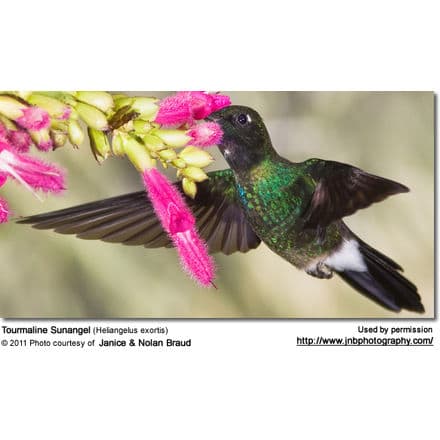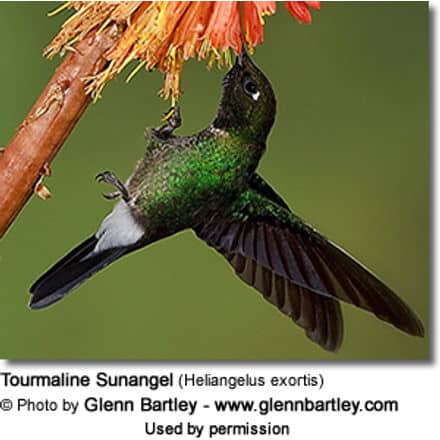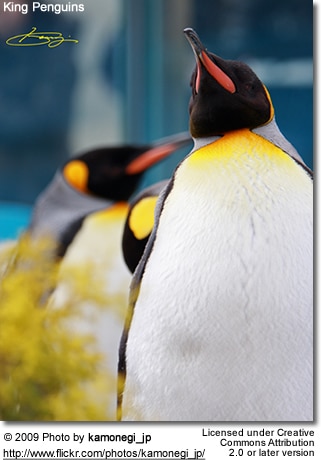Tourmaline Sunangel (Heliangelus exortis)
The Tourmaline Sunangels (Heliangelus exortis) are South American hummingbirds that occur naturally in Colombia and Ecuador.
They were previously considered one species with the Flame-throated Sunangel, but, in 2005 the South American Classification Committee (SACC) decided to split them into Heliangelus exortis (Tourmaline Sunangels) and micraster (Flame-throated or Little Sunangel).
Distribution / Habitat
The Tourmaline Sunangels occur in the Andes of Colombia and on the east slope of the Andes mountain range in adjacent northwestern Ecuador.
They are locally common in humid and wet forest borders, bushy forest clearings, shrubby pastures and hedges, at elevations from.
They usually occur above elevations 7,546 feet or 2,300 meters, but can be found as low as 5,000 feet (1,500 meters) or as high as 11,155 feet (3,400 meters).

Description
Tourmaline Sunangels measure about 4″ (10.2 cm) in length; and have a short bill that is about 0.6″ or 15 mm long.
Males:
- Green upper plumageGlossy green frontletGlittering violet-blue gorget (throat patch)Large patch on the lower throatGlossy green chestUndertail coverts (feathers) are whiteLong, forked tail that is purplish black except for the bronze-green central feathers.
Female:
- Bronze-green upper plumage.Glittering green forecrown.White throat and under tail coverts (feathers)Glossy green chest turning buffy white disked green on the abdomenTail shorter than male’s and less forked
Juvenile:
- The throat is white disked violet and rose.Some have greenish-grey chests.
Similar Species.
- The male resembles the Greenish Puffleg but is larger and has a shorter bill, and has white under tail coverts (feathers). Pufflegs also have prominent leg puffs.The Purple-backed Thornbill has a shorter and less forked tail and the throat is white; and has a much shorter bill.The Flame-throated Sunangel has an orange throat patch.
Hummingbird Resources
- Hummingbird Information
- Hummingbird Amazing Facts
- Attracting Hummingbirds to Your Garden
- Hummingbird Species
- Feeding Hummingbirds
Diet / Feeding
The Tourmaline Sunangels mostly feed by clinging to flowers with their wings outstretched in a “V” while feeding on nectar taken from a variety of brightly colored, scented small flowers of trees, herbs, shrubs and epiphytes. They favor flowers with the highest sugar content (often red-colored and tubular-shaped) and seek out, and aggressively protect, those areas containing flowers with high energy nectar. They use their long, extendible, straw-like tongues to retrieve the nectar while hovering with their tails cocked upward as they are licking at the nectar up to 13 times per second. Sometimes they may be seen hanging on the flower while feeding.
They usually forage low in open and shrubby areas, or along forest borders.
Many native and cultivated plants on whose flowers these birds feed heavily rely on them for pollination. The mostly tubular-shaped flowers actually exclude most bees and butterflies from feeding on them and, subsequently, from pollinating the plants.
They may also visit local hummingbird feeders for some sugar water, or drink out of bird baths or water fountains where they will either hover and sip water as it runs over the edge; or they will perch on the edge and drink – like all the other birds; however, they only remain still for a short moment.
They also take some small spiders and insects – important sources of protein particularly needed during the breeding season to ensure the proper development of their young. Insects are often caught in flight (hawking); snatched off leaves or branches, or are taken from spider webs. A nesting female can capture up to 2,000 insects a day.
Males establish feeding territories, where they aggressively chase away other males as well as large insects – such as bumblebees and hawk moths – that want to feed in their territory. They use aerial flights and intimidating displays to defend their territories.

Breeding / Nesting
Tourmaline Sunangels mostly breed between March to August.
Hummingbirds are solitary in all aspects of life other than breeding; and the male’s only involvement in the reproductive process is the actual mating with the female. They neither live nor migrate in flocks; and there is no pair bond for this species. Males court females by flying in a u-shaped pattern in front of them. He will separate from the female immediately after copulation. He does not participate in choosing the nest location, building the nest or raising the chicks
The female Tourmaline Sunangel is responsible for building the cup-shaped nest out of plant fibers woven together and green moss on the outside for camouflage in a protected location in a shrub, bush or tree. She lines the nest with soft plant fibers, animal hair and feather down, and strengthens the structure with spider webbing and other sticky material, giving it an elastic quality to allow it to stretch to double its size as the chicks grow and need more room. The nest is typically found on a low, thin horizontal branch.
The average clutch consists of one white egg, which she incubates alone, while the male defends his territory and the flowers he feeds on. The young are born blind, immobile and without any down.
The female alone protects and feeds the chicks with regurgitated food (mostly partially-digested insects since nectar is an insufficient source of protein for the growing chicks). The female pushes the food down the chicks’ throats with her long bill directly into their stomachs.
As is the case with other hummingbird species, the chicks are brooded only the first week or two, and left alone even on cooler nights after about 12 days – probably due to the small nest size. The chicks leave the nest when they are about 7 – 10 days old.
Calls / Vocalizations / Sounds
This hummingbird is generally quiet.
Alternate (Global) Names
Chinese: ????? … Czech: kolib?ík turmalinový … Danish: Turmalinsolalf … Dutch: Toermalijnzonnekolibrie … Finnish: Ecuadorinenkelikolibri, Turmaliinienkelikolibri … French: Héliange tourmaline … German: Grünband-Sonnennymphe, Turmalinsonnennymphe … Italian: Angelo del sole tormalina … Japanese: torumarintenshihachidori … Norwegian: Turmalinsolengel … Polish: lordzik fioletowogardly, Lordzik fioletowogard?y … Russian: ???????????? ????? … Slovak: nymfárik turmalínový … Spanish: Ángel Gorgiturmalina, Colibrí Turmalina … Swedish: Turmalinsolängel




